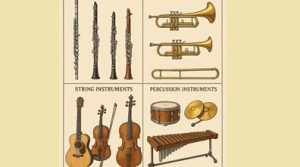Song Structure: The Blueprint of Music [Plus Examples]
Song Structure: The Blueprint of Music [Plus Examples]
Every time I attempt to start a blog post (like this one) without creating an outline first, I find myself writing disjointed, ineffective copy.
An outline acts as the skeleton of an article, blog post, or short story. While it’s certainly possible to “wing it,” it’s not the most efficient approach.
This is why we are taught the skill of outlining from a young age, even in elementary school.

Similarly, every song, regardless of genre, is built upon an underlying structure. These basic song structures serve as the outlines—or blueprints—of music.
Just as starting with an outline has consistently helped me improve my writing, using a song structure has always guided my songwriting, composition, and production process.
In this post, we’ll explore the following:
- What song structure is and how it function
- Common song structure examples
- How to analyze song structure to enhance songwriting and production skills
Let’s dive in!
What is a Song Structure?
Song structure refers to the “horizontal” arrangement of a song, playing a critical role in the songwriting process.
Typically, it is divided into sections, with each section labeled as verse, chorus, bridge, pre-chorus, etc.
Song structures are also commonly referred to as the “form”(that is the song form) of the song, especially in classical music.
Why is It Important?
The song structure is essential because it provides direction and purpose to a song. Without it, a song can easily feel aimless and disjointed.
A well-crafted song structure strikes a balance between repetition and fresh material. This balance is crucial to maintaining the listener’s attention from beginning to end.
The Individual Building Blocks of Song Structure
Here are the most common elements of song structure that you’ll encounter in popular songs:
Intro
The intro’s main goal is to grab the listener’s attention right from the start. Intros can vary in length, ranging from 16 or 32 bars to a single beat.
Some intros are instrumental, while others are lyrical. In some cases, a song might skip the intro and go directly into the main section.
For example, A Hard Day’s Night by The Beatles starts with a striking, ambiguous chord. Meanwhile, Bohemian Rhapsody by Queen introduces an iconic piano riff before Freddie Mercury’s powerful voice kicks in for the first verse.
Verse
Verses typically provide the narrative or set the scene in a song. The lyrics of the verses often tell a story or paint a vivid picture.
In Hallelujah by Leonard Cohen, for instance, the verses detail the breakdown of a relationship, with each verse adding another layer to the narrative, while the chorus simply repeats the title.
Verses usually appear in multiples of four bars. In Hallelujah, each verse has 16 bars.
Pre-Chorus
The pre-chorus, a device that has become more popular in recent years, helps build anticipation and prepares the listener for the chorus.
It typically lasts between 4-8 bars, though this can vary. A great example of a pre-chorus is in Still Into You by Paramore, where the drop to vocals and palm-muted guitar amplifies the impact of the ensuing chorus.
Chorus
The chorus is often the most critical section of a song. It’s the part that sums up the song’s essence, the part you sing along to with the windows down.
The chorus is intended to be catchy, memorable, and the focal point of the song. Songwriters devote significant effort to make the chorus as “hooky” as possible, often repeating the title or a key phrase.
The typical chorus is 8 or 16 bars long. For instance, Pharrell’s Happy is largely remembered for its infectious chorus.
Bridge
The bridge provides a musical “twist,” offering a refreshing contrast to the repetitive verses and choruses.
Typically, the bridge lasts around 8 bars and is commonly placed between the second and third chorus.
A great example of a bridge is in Super Trouper by ABBA, where a change in mood gives the song a sense of relief before returning to the final chorus.
Outro
The outro, or the song’s ending, can either fade out with the chorus or introduce completely new material. One of the most iconic outros is from Over the Hills and Far Away by Led Zeppelin, where the guitar fades into the distance, enriched by a pedal steel sound.
Interlude
Interludes, often instrumental, serve as a pause or break in the song. They can be as short as four bars or extend to a minute or more.
An example is in Pet Sounds by The Beach Boys, where animal sounds act as an interlude between two tracks, helping maintain energy and engagement.
Instrumental Solo
An instrumental solo allows one or more instruments to take the spotlight, either with improvised or pre-composed licks.
A famous example comes from Comfortably Numb by Pink Floyd, where the guitar solos elevate the emotional impact of the song.
Genre-Specific Song Structures
Different genres often feature unique song structures or elements.
For instance, classical music is typically organized into forms like Rondo (A-B-A-C-A) and Sonata (Exposition-Development-Recapitulation), which are rarely found in other genres.
Jazz often features song structures like the 12-bar blues, 32-bar (AABA) form, or 16-bar variations, providing a foundation for improvisation.
EDM songs, while following a similar structure to pop, often feature instrumental breakdowns designed to build energy on the dance floor.
Popular Song Structures by Genre
Pop
Pop songs tend to follow the structure: Verse – Chorus – Verse – Chorus – Bridge – Chorus. This structure is flexible, as evidenced by Michael Jackson’s Billie Jean and The Weeknd’s Can’t Feel My Face.
Both songs vary the chorus and incorporate unique elements to maintain interest while retaining the core pop structure.
Jazz
Jazz music commonly employs the 12-bar blues and 32-bar AABA song forms, both of which allow space for improvisation.
The 12-bar blues, in particular, is one of the simplest and most iconic forms, as seen in Charlie Parker’s Cool Blues.
EDM
In EDM, the typical song structure is Verse – Chorus – Verse – Chorus – Bridge – Chorus.
The key difference is the emphasis on instrumental breakdowns that build or release energy.
An example of this is Avicii’s Wake Me Up, where the arrangement focuses on creating a flow state perfect for dancing.
How to Do Song Structure Analysis
I recommend that musicians and producers regularly analyze song structure.
You can do this by either marking each section as you listen to a song or by using your DAW to mark regions and sections with tempo-matched markers.
This analysis will help you become familiar with the specific structures that define your favorite genres.

Final Thoughts
Establishing your song structure early on will streamline your songwriting, production, and composition processes.
Understanding the song forms that are popular in different genres will help you create music that fits within those traditions or offers something fresh.
Be sure to check out my post on songwriting for more insights, and when you’re ready to dive into music production, explore my guide to producing music.
Thanks for reading!






https://pq.hosting/news/horvatija-zapuschena-42-ja-lokacija-s-10-gbps
In my opinion you commit an error. Let’s discuss. Write to me in PM, we will talk.
buy hong kong virtual phone number online https://virtual-local-numbers.com/countries/57-hongkong.html for calls, sms, registration (otp)
buy virtual phone number for sms
yachtcharter spanien https://eurosegeln.com/yachtcharter-spanien
https://podgoricacar.me/
https://partyflock.nl/topic/1186927:ENTER-THE-SOUND-24-hour-Techno-Hardtechno-open-air#m51002299
https://www.bandlab.com/roscargr
Book Tickets Online
https://www.facer.io/u/roscar
виртуальный номер азербайджана
cyprus virtual number https://virtual-local-numbers.com/countries/46-cyprus.html
boot mieten ohne fГјhrerschein
buy voip number with crypto
yachtcharter kroatien
индивидуалки спб частные объявления
https://www.tripadvisor.it/Profile/F7040OXpedrob
https://www.jwlconstruction.org/profile/findycarde9710/profile
virtual mobile number for otp
https://kumu.io/findycartr/findycar-tr
https://www.storeboard.com/findycar2
https://www.efunda.com/members/people/show_people.cfm?Usr=findycarnet&Search_Cat1=All%20Fields&Search_Key1=findycarcom&Search_Cat2=All%20Fields&Search_Key2=&Search_Cat3=All%20Fields&Search_Key3=&And_OR=and
https://www.atlasobscura.com/users/findycarro
I’m really inspired together with your writing skills as well
as with the layout on your weblog. Is that this a paid subject matter or didd you customize it yourself?
Anyway stay up the excellent high quality writing, it is uncommon to look
a nice eblog like this onee nowadays.. https://Fortune-Glassi.Mystrikingly.com/
car rent uae dubai
Certainly. I agree with told all above.
——
vietnam virtual number